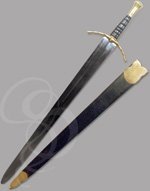
Categories
- New Arrivals
- Armor
- Axes & Maces
- Bargains
- Clothing
Costumes - Collectibles
- Daggers
- Displays
- Engravable Items
- Flintlocks & Projectile
- Jewelry
- Kids Stuff
- Knives
- Larp and Foam
- Lightsabers
- Letter Openers
- Military Replicas
- Movie &
Licensed Items - Shields
- SpearsPolearms
- Strangeblade
Strange & Unusual
Stuff - Swords
- Tankards &
Goblets - Browse All Products
Metallurgy of Swords
The Bronze Age
(Where it all started)
Bronze was the first really useful metal to be used extensively for tools and weapons. The first historic traces of bronze weapons appear in Asia and Africa as
early as 4,500 BC. Bronze is an metal alloy, that is, a mixture composed of copper and tin. Other elements such as zinc are also often included in the alloy.
Bronze was popular in the early ages primarily because of its low melting temperature. The technology of the time supported limited forging temperatures (i.e. the ol' campfire).
Since bronze melts at lower temperatures, forging blades of bronze imposed less of a technological challenge. Unfortunately, bronze swords tended to bend at the most inopportune
moments (i.e. as you were smiting that 6-foot-4-inch greek hoplite bearing down on you with raised javelin). The blades of bronze swords had to be constantly straightened under foot,
or (for the really cool warriors) in your teeth (okay, so we made that up). The period in which bronze was most commonly used is cryptically referred to as the "Bronze Age."
The Iron Age
The Bronze age gave way to the Iron Age which began around 1,000 BC. Iron most likely became more commonly used than bronze because of its great abundance. Iron is one of the most abundant elements on Earth. It's not normally found in its elemental form, but rather as iron ore, which is a form of rock in which the iron is combined with oxygen. The oxygen is removed from the ore by heating it, a process known as smelting (in it's original and lesser known meaning, smelting actually meant the heating of bronze, graham crackers, and marshmellows into a guey and completely unpalatable camp food. Famed army cook Arnold Smores replaced Bronze with chocolate in the mid 1800s, yielding a more nutritious, if less well-preserved, gourmet). In the early days of metal working the ore was heated in a charcoal furnace or a forge. In the high temperature of the forge the oxygen in the ore is replaced by carbon from the coal. While the ore is a hot glowing mass, it is removed from the forge and pounded with sledges to separate the impurities and yield a purer form of iron. If you thought bronze blades were floppy, blades made of pure iron were pathetic as weapons. Iron is a ductile metal which means it bends easily. Also ductile metals normally do not hold a sharpened edge very well.
Steel
(a better iron)
Steel is an alloy of iron and carbon with small amounts of other elements often present. Because of this, steel is much
stronger and more flexible than iron. The harder metal allows the blade to take a much keener edge. The greater the carbon
content, the stronger and harder the steel, however, higher carbon content also makes the steel more brittle. Varying the
amount of carbon and its distribution in the alloy controls the qualities of the resulting steel.
- Mild steel .10% to .25% carbon
- Medium carbon steel .25% to .45% carbon
- High carbon steel .45% to .95% carbon
- Ultrahigh carbon steel .95% to 2.1% carbon
Ultra high carbon steel can be very brittle but with proper heat treating (and lots 'o love) the strength of the steel may be maintained and the brittleness minimized. This process is known as tempering, and works in relationships as well as swords.
Some swords are made of layered metals of different steels. Softer more flexible steels are used on the inner layers and harder stronger steels for the outer layers. This creates a weapon that is flexible and yet still holds a fine edge.
Stainless Steel Blades
Stainless steel was first introduced in the early 1900s. Stainless steel is an iron alloy with chromium and other elements. Stainless steel is a corrosion resistant steel. It is virtually immune to rust, discoloration, and corrosion. It can be highly polished resembling a precious metal. There are many different grades of stainless steel. Some grades can not hold an edge but when carbon is added to the alloy it can hold an edge.
Choosing the Right Steel for Your Blade
If you are looking for an authentic blade, high carbon steel is the best choice. It can be sharpened to a fine edge. If unsharpened it may be used a a battle ready sword (providing the rest of the sword is rated for that use). However, carbon steels do rust and require some maintenance. They should be treated periodically with a light coat of mineral oil or firearm oil in order to keep them shiny and rust free. A stainless steel blade makes a great ornamental sword. It is extremely easy to care for and can be polished to high shine.
Strongblade.com: Swords, Daggers and Armor
 This Medieval Arming Sword features a high carbon steel blade.
This Medieval Arming Sword features a high carbon steel blade.
Click the image to see detailed information about it.